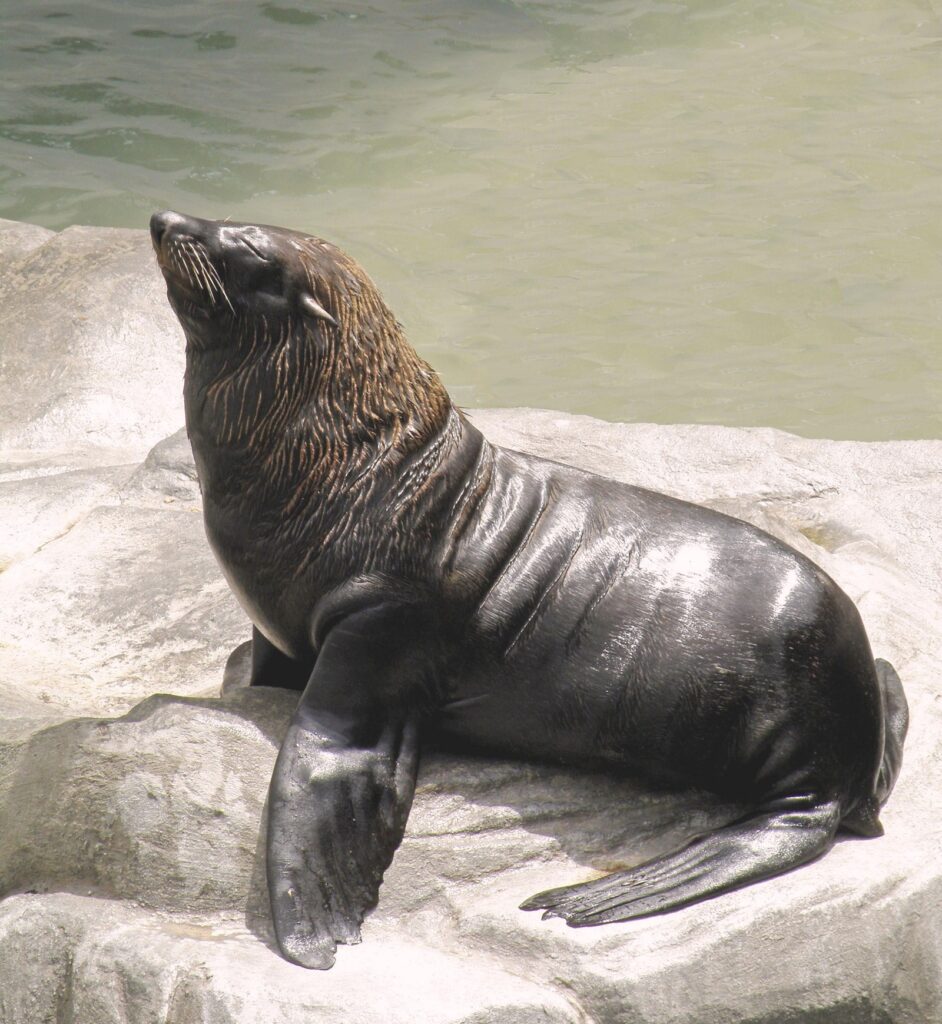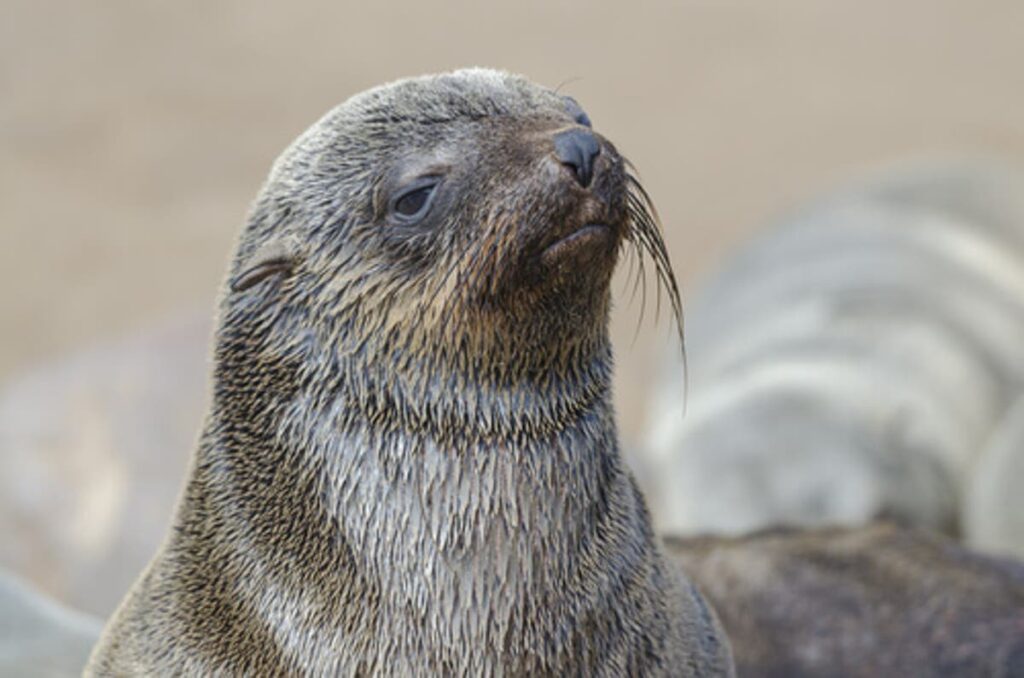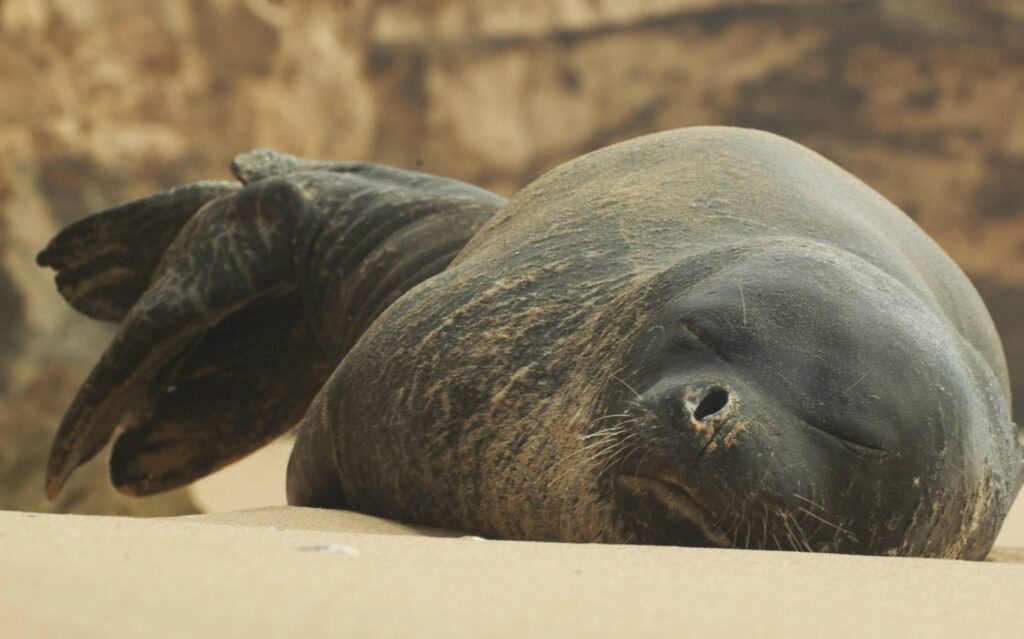The Sea Lion is an aquatic mammal that is mostly found in the oceans and southern seas. It is a carnivorous animal that feeds on fish, octopus and squid. They are long and thick and despite the inequality in size and weight between the sexes they consume the same amount of food. To learn more about these marine creatures you must continue reading.

The sea lion
The sea lion (Otaria flavescens), is a variety of pinniped aquatic mammal that is part of the Otariidae family and for which they also receive the name of otarinos. They look similar to seals, but heavier. They populate a large section of the world's oceans and seas, in which they feed on fish, octopus, squid, shrimp, among others.
Some of them are simply called “wolves”, but others have very particular names such as funny sea lion, one-hair sea lion, southern sea lion, South American sea lion or simply sea lion.
Description
It has a dark brown color when it reaches adulthood but is black in its youth. Adult males usually weigh about 300 kilograms, which is twice the weight of females. They exhibit a kind of layer of reddish-brown fur above their neck, this "mane" being the reason why they are called "sea lions".
Their existence is carried in groups of about 15 specimens, made up of the male, his harem, and a few young. Throughout the summer, in December and January, they go to give birth to places under protection where thousands of specimens gather. Its gestation process can last almost a year, from which a single offspring results.
Throughout the breeding season, males usually fight for territory and females, and it is normal for them not to consume food during that time. Its life can be prolonged for about 25 to 50 years. Sea lions are known as a very territorial species.
Food
In their diet we can regularly get fish, octopus, squid, penguins and other seabirds. They consume 15 to 25 kilograms of food per day and at the same time are hunted by killer whales and sharks.
The common sea lion is an essential variety of the coastal ecosystem where it moves considerably on the continental shelf. However, females are usually more coastal than males in their transfers. Their diet was studied in northern and central Patagonia and was based on the identification of otoliths, (solid remains with which the age of a fish is determined), fish and cephalopod beaks obtained from their stomach contents.
Among the most important prey items were hake (Merluccius hubbsi), common squid (Illex argentinus and Doryteuthis gahi), squid (Illex argentinus and Doryteuthis gahi) and octopus (Octopus tehuelchus and Enteroctopus megalocyathus). Also included are the anchovy (Engraulis anchoita), the nototenias (Patagonotothen cornucola and P. ramsayi), the sea salmon (Pseudopercis semifasciata), the pollock (Genypterus blacodes), and various elasmobranchs. Among the crustaceans, several species were found, but they are not relevant, except in years of profusion of shrimp (Pleoticus muelleri).
Based on these results, it is inferred that the common wolf is an opportunistic variety that takes advantage of a wide range of resources with a propensity to catch particularly species such as demersal and benthic, some of them of commercial relevance. As part of the parasites of the common wolf, nematodes have been found (Anisakis simplex, Contracaecum ogmorhini, Pseudoterranova decipiens, and Uncinaria sp.); Likewise, the acanthocephalus (Corynosoma australe) and the cestode (Diphyllobothrium pacificum) were obtained.
Habitat
It populates the southern coast of South America. In the Pacific Ocean it is located on the coasts of Peru and Chile; in the Galapagos Islands (Ecuador) and in Malpelo and Gorgona Islands (Colombia). In the Atlantic Ocean it dwells from the coast of Uruguay, and the coasts of the Argentine Sea, both in the continental part of Argentine Patagonia as well as in the Falkland Islands and the South Sandwich Islands. It is also found in the southern seas of Africa, Australia and New Zealand.
Danger of extinction
Long ago they were hunted by humans to obtain their meat and oil, but the main reason for their hunting today is the use that the skins of their newborn pups, called "popos" (from the English puppy), are given to them. It was in the fur industry. Despite the fact that their direct exploitation in Patagonia has been prohibited, the one-hair sea lions interact with all kinds of fisheries and in very different ways. Throughout the 1990s significant mortality rates were calculated for various types of bottom and pelagic trawling.
The total mortality per year ranged between 150 and 600 specimens. It also interacts with gillnet fisheries in the Province of Buenos Aires which are destined for shark and croaker, in which it feeds on part of the catch, reducing its economic value. but it is not entangled. It also interacts with the longline fishing in the San Matías Gulf in which it spoils the catch and is subjected to persecution by the fishermen.
Another class of interactions with fisheries are those related to particular or ecological ones and that account for the indirect consequences of fishing exploitation on prey that are frequent for other predators in the marine ecosystem. As the sea lion is a notorious and abundant species in the marine system, it is predictable that it interacts with fisheries by consuming prey similar to that of the fishery.
The content of the diet of a predator such as the sea lion is expected to alter as the relative abundances of its potential prey change; particularly considering that hake and common squid are the most relevant prey and also make up the most important target species for fisheries in the area. Therefore, the impact that fisheries have on the abundance of these varieties will end up altering the diet of large predators.
A multispecific model was developed that included common squid, anchovy, hake, and the one-hair sea lion in northern and central Patagonia. The results obtained indicate that reciprocal effects are evident between varieties. that were included, the most significant being the harvest of squid and hake, which could negatively influence the populations of the sea lion according to the intensity of each harvest.
The number of sea lions on the Patagonian coast is expanding even though it has not yet returned to its original population size. The disadvantages of accidental mortality in fishing gear, although they have been previously considered, have not yet been estimated by the fisheries management system. The situation of the accompanying fauna is not part of the assessment system for fishery resources and in the on-board observer programs only issues related to the target species are assessed.
Regarding tourism, although it cannot be considered a threat or a conservation inconvenience, as mentioned above, the new locations of sea lions are located in areas of private exploitation, with little protection or control on the part of the protectors of fauna or the management system of protected areas.
Varieties of the Sea Lion
The otarine family, which is better known as sea lions, is spread over different parts of the planet. Below we will give you details of each species and its natural environment.
Australian and South African Fur Seal
Scientifically it is called Arctocephalus pusillus and, as its name indicates, it can be found on the Australian coast, particularly on the islands of the Bass Strait, and on the South African coast, specifically in Namibia. It is a very peaceful and sociable animal, very friendly in the water and loves to accompany divers to depths of 60 meters. On land they are usually somewhat nervous and fearful of human presence.
South American Sea Lion
The Otaria flavescens of this region are given different names, such as sea lion of a hair or seal of Patagonia. It populates the Pacific and southern Atlantic coasts of South America and can be found in Ecuador, Chile, Argentina and Uruguay. The South American sea lion is dark brown in color, the males weigh about 300 kilos, twice the females, and they are recognized by having a layer of reddish hair on their neck. They live in colonies made up of a male and his harem of females, and have the company of young specimens.
Galapagos Sea Lion
It is also known as a fur seal, its scientific name being Arctocephalus galapagoensis. It is an endemic variety of the Galapagos Islands, in Ecuador, and they do not migrate. Their daytime diet includes deep-sea fish and at night they feed on those that come to the surface.
The males have a length of 1,5 meters and a weight of about 65 kilos. On the other hand, the females are smaller and lighter. It is the smallest species within the family. They are organized in reproductive colonies in caves, in which the females barely give birth to one offspring per season.
New Zealand Fur Seal
The Arctophoca fosteri or southeastern fur seal inhabits the southern coast of Australia and the South Island of New Zealand. The territories of males can be located in the Cook Strait and, as an interesting fact, the colonies of Australia and those of New Zealand do not mix with each other, despite being of the same variety.
The males have a weight of about 150 kilos and reach a length of two meters; while the weight of the females is 50 kilos and its length is 1,5 meters. Both sexes show forward-curving hind flippers, pointed nose, and long white whiskers. Its body has a grayish brown color on the back and a lighter color on the belly.
Antarctic Fur Seal
The Arctophoca gazella resides in the Antarctic seas and in the southern seas of Argentina and Chile. The farthest north that they have been seen was in the Kerguelen Islands, located about 2.000 kilometers from Antarctica. When compared to the other members of the family, the shorter snout of the Antarctic fur seal can be noted. On the other hand, the males, which reach two meters in length and weigh up to 230 kilos, show a dark brown skin, while in the females and the young it is gray. Their diet consists of krill and eventually fish.
South American Fur Seal
Its scientific name is Arctophoca australis australis, although it is popularly known as the two-hair sea lion. It is an endemic variety of South America, which populates the south of Brazil, Uruguay, Argentina and Chile. Sexual dimorphism is also present in this species, in which males are larger than females (two meters and 200 kilos versus 1,5 meters and 60 kilos, respectively).
The diet of this sea lion is made up of crustaceans, cephalopods and fish; it is an animal of opportunity that eats what it gets in the sea. The sea lion is a very popular animal in the southern hemisphere, where it can be seen on the coasts, grouping in colonies among the rocks or on the sandy beaches.
Some items we recommend are:



